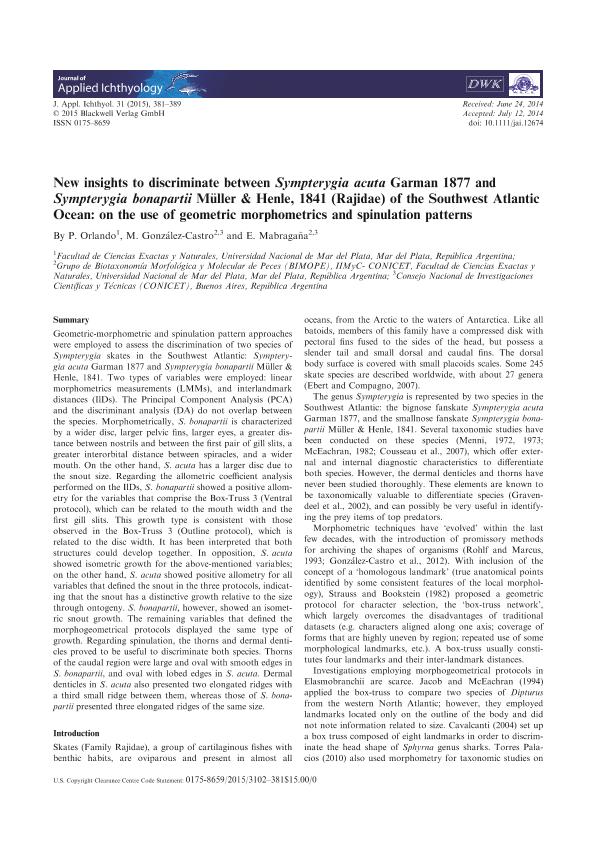Artículo
New insights to discriminate between Sympterygia acuta Garman 1877 and Sympterygia bonapartii Müller & Henle, 1841 (Rajidae) of the Southwest Atlantic Ocean: On the use of geometric morphometrics and spinulation patterns
Fecha de publicación:
04/2015
Editorial:
Wiley Blackwell Publishing, Inc
Revista:
Journal Of Applied Ichthyology-zeitschrift Fur Angewandte Ichthyologie
ISSN:
0175-8659
Idioma:
Inglés
Tipo de recurso:
Artículo publicado
Clasificación temática:
Resumen
Geometric-morphometric and spinulation pattern approaches were employed to assess the discrimination of two species of Sympterygia skates in the Southwest Atlantic: Sympterygia acuta Garman 1877 and Sympterygia bonapartii Müller & Henle, 1841. Two types of variables were employed: linear morphometrics measurements (LMMs), and interlandmark distances (IlDs). The Principal Component Analysis (PCA) and the discriminant analysis (DA) do not overlap between the species. Morphometrically, S. bonapartii is characterized by a wider disc, larger pelvic fins, larger eyes, a greater distance between nostrils and between the first pair of gill slits, a greater interorbital distance between spiracles, and a wider mouth. On the other hand, S. acuta has a larger disc due to the snout size. Regarding the allometric coefficient analysis performed on the IlDs, S. bonapartii showed a positive allometry for the variables that comprise the Box-Truss 3 (Ventral protocol), which can be related to the mouth width and the first gill slits. This growth type is consistent with those observed in the Box-Truss 3 (Outline protocol), which is related to the disc width. It has been interpreted that both structures could develop together. In opposition, S. acuta showed isometric growth for the above-mentioned variables; on the other hand, S. acuta showed positive allometry for all variables that defined the snout in the three protocols, indicating that the snout has a distinctive growth relative to the size through ontogeny. S. bonapartii, however, showed an isometric snout growth. The remaining variables that defined the morphogeometrical protocols displayed the same type of growth. Regarding spinulation, the thorns and dermal denticles proved to be useful to discriminate both species. Thorns of the caudal region were large and oval with smooth edges in S. bonapartii, and oval with lobed edges in S. acuta. Dermal denticles in S. acuta also presented two elongated ridges with a third small ridge between them, whereas those of S. bonapartii presented three elongated ridges of the same size.
Archivos asociados
Licencia
Identificadores
Colecciones
Articulos(IIMYC)
Articulos de INSTITUTO DE INVESTIGACIONES MARINAS Y COSTERAS
Articulos de INSTITUTO DE INVESTIGACIONES MARINAS Y COSTERAS
Citación
Orlando, P.; González Castro, Mariano; Mabragaña, Ezequiel; New insights to discriminate between Sympterygia acuta Garman 1877 and Sympterygia bonapartii Müller & Henle, 1841 (Rajidae) of the Southwest Atlantic Ocean: On the use of geometric morphometrics and spinulation patterns; Wiley Blackwell Publishing, Inc; Journal Of Applied Ichthyology-zeitschrift Fur Angewandte Ichthyologie; 31; 2; 4-2015; 381-389
Compartir
Altmétricas




